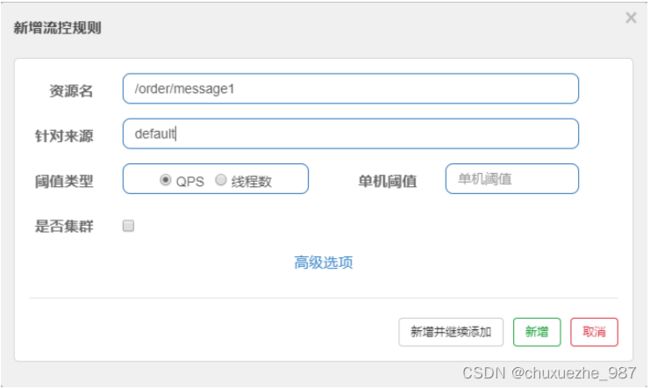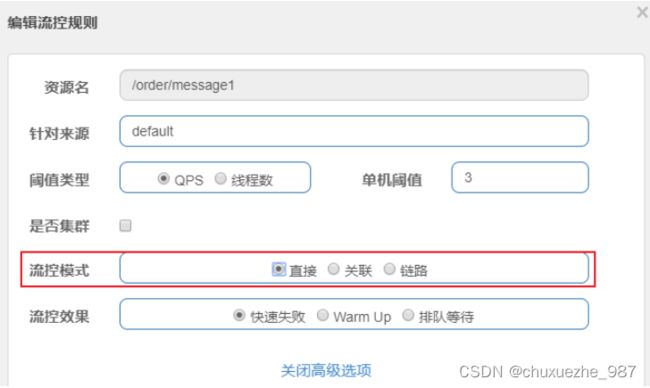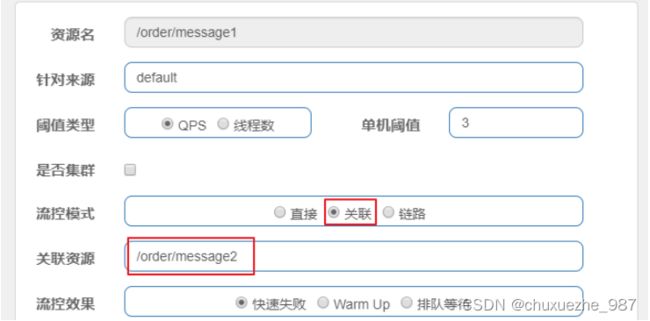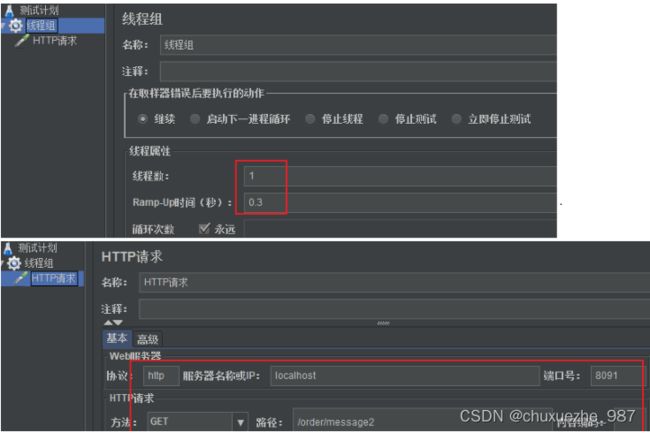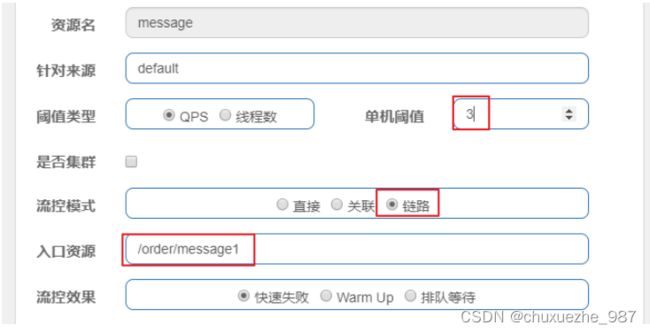Spring Cloud Alibaba-Sentinel规则
1 流控规则
流量控制,其原理是监控应用流量的QPS(每秒查询率) 或并发线程数等指标,当达到指定的阈值时
对流量进行控制,以避免被瞬时的流量高峰冲垮,从而保障应用的高可用性。
- 第1步: 点击簇点链路,我们就可以看到访问过的接口地址,然后点击对应的流控按钮,进入流控规则配置页面。新增流控规则界面如下:
资源名:唯一名称,默认是请求路径,可自定义
针对来源:指定对哪个微服务进行限流,默认指default,意思是不区分来源,全部限制
阈值类型/单机阈值:
QPS(每秒请求数量): 当调用该接口的QPS达到阈值的时候,进行限流
线程数:当调用该接口的线程数达到阈值的时候,进行限流
是否集群:暂不需要集群
接下来我们以QPS为例来研究限流规则的配置。
1.1 简单配置
我们先做一个简单配置,设置阈值类型为QPS,单机阈值为3。即每秒请求量大于3的时候开始限流。
接下来,在流控规则页面就可以看到这个配置。
然后快速访问 /order/message1 接口,观察效果。此时发现,当QPS > 3的时候,服务就不能正常响应,而是返回Blocked by Sentinel (flow limiting)结果。
1.2 配置流控模式
点击上面设置流控规则的编辑按钮,然后在编辑页面点击高级选项,会看到有流控模式一栏。
sentinel共有三种流控模式,分别是:
- 直接(默认):接口达到限流条件时,开启限流
- 关联:当关联的资源达到限流条件时,开启限流 [适合做应用让步]
- 链路:当从某个接口过来的资源达到限流条件时,开启限流
下面呢分别演示三种模式:
- 直接流控模式
直接流控模式是最简单的模式,当指定的接口达到限流条件时开启限流。上面案例使用的就是直接流控模式。
- 关联流控模式
关联流控模式指的是,当指定接口关联的接口达到限流条件时,开启对指定接口开启限流。
第1步:配置限流规则, 将流控模式设置为关联,关联资源设置为的 /order/message2。
第3步:通过postman软件向/order/message2连续发送请求,注意QPS一定要大于3
第4步:访问/order/message1,会发现已经被限流
- 链路流控模式
链路流控模式指的是,当从某个接口过来的资源达到限流条件时,开启限流。它的功能有点类似于针对来源配置项,区别在于:针对来源是针对上级微服务,而链路流控是针对上级接口,也就是说它的粒度更细。
第1步: 编写一个service,在里面添加一个方法message
@Service
public class OrderServiceImpl3 {
@SentinelResource("message")
public void message() {
System.out.println("message");
}
}第2步: 在Controller中声明两个方法,分别调用service中的方法m
@RestController
@Slf4j
public class OrderController3 {
@Autowired
private OrderServiceImpl3 orderServiceImpl3;
@RequestMapping("/order/message1")
public String message1() {
orderServiceImpl3.message();
return "message1";
}
@RequestMapping("/order/message2")
public String message2() {
orderServiceImpl3.message();
return "message2";
}
}第3步: 禁止收敛URL的入口 context
(1) 暂时将SpringCloud Alibaba的版本调整为2.1.1.RELEASE
2.1.1.RELEASE (2) 配置文件中关闭sentinel的CommonFilter实例化
spring:
cloud:
sentinel:
filter:
enabled: false(3) 添加一个配置类,自己构建CommonFilter实例
package com.itheima.config;
import com.alibaba.csp.sentinel.adapter.servlet.CommonFilter;
import org.springframework.boot.web.servlet.FilterRegistrationBean;
import org.springframework.context.annotation.Bean;
import org.springframework.context.annotation.Configuration;
@Configuration
public class FilterContextConfig {
@Bean
public FilterRegistrationBean sentinelFilterRegistration() {
FilterRegistrationBean registration = new FilterRegistrationBean();
registration.setFilter(new CommonFilter());
registration.addUrlPatterns("/*");
// 入口资源关闭聚合
registration.addInitParameter(CommonFilter.WEB_CONTEXT_UNIFY, "false");
registration.setName("sentinelFilter");
registration.setOrder(1);
return registration;
}
}第4步: 控制台配置限流规则
第5步: 分别通过 /order/message1 和 /order/message2 访问, 发现2没问题, 1的被限流了
1.3 配置流控效果
- 快速失败(默认): 直接失败,抛出异常,不做任何额外的处理,是最简单的效果
- Warm Up:它从开始阈值到最大QPS阈值会有一个缓冲阶段,一开始的阈值是最大QPS阈值的1/3,然后慢慢增长,直到最大阈值,适用于将突然增大的流量转换为缓步增长的场景。
- 排队等待:让请求以均匀的速度通过,单机阈值为每秒通过数量,其余的排队等待; 它还会让设置一个超时时间,当请求超过超时间时间还未处理,则会被丢弃。
